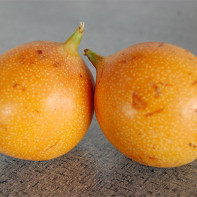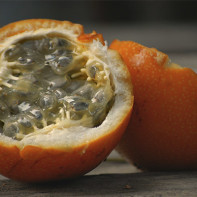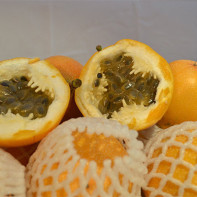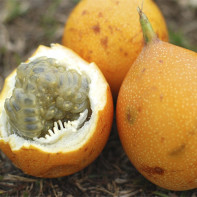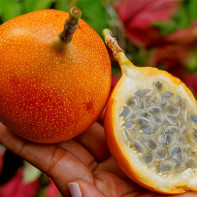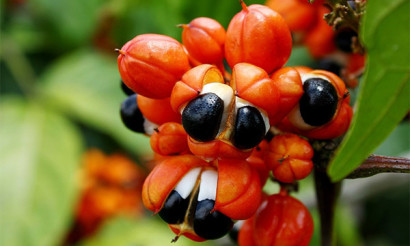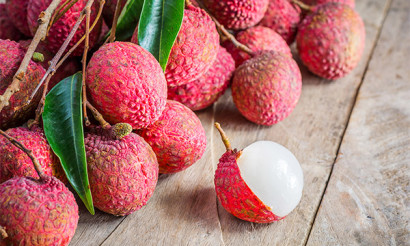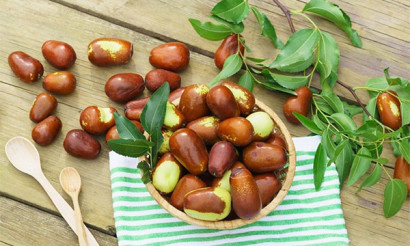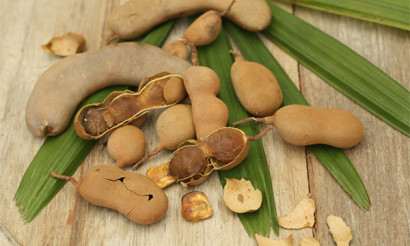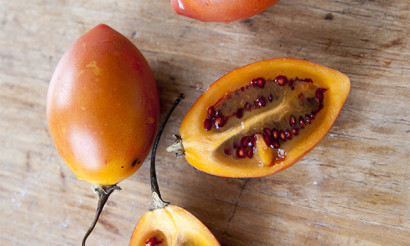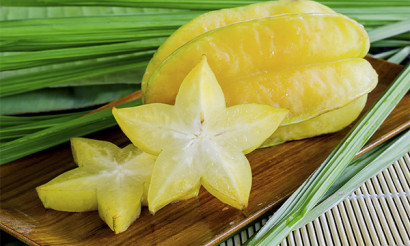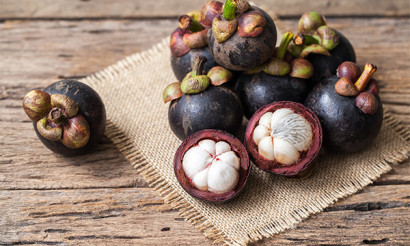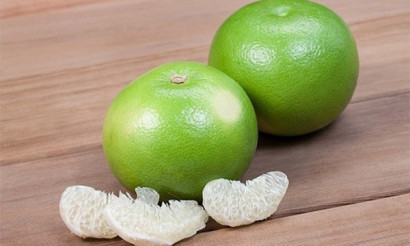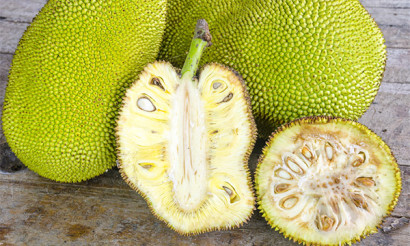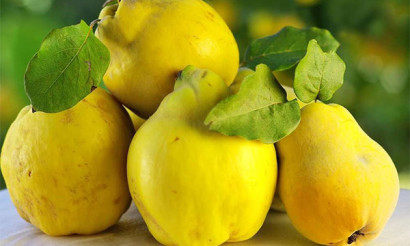Granadilla: what it is, useful properties and contraindications
Granadilla is a popular tropical fruit in many warm countries.
- What is grenadilla
- What it looks like
- Types
- Where it grows
- How pomegranadilla differs from passion fruit
- Composition and Calories
- Useful properties of the grenadilla fruit
- For Women
- For Men
- Pregnancy
- Breastfeeding
- For children
- When losing weight
- Harm and Contraindications
- How to choose and store
- How to eat grenadilla properly
- How to peel pomegranadilla
- Is it possible to eat the pit?
- Cooking Usage
- Exotic Spring Salad
- Sweet pomegranadilla sauce for meat
- Pomegranadilla fruit mousse
- Cheese casserole "Exotic"
- Tropical Afternoon Pudding
- Interesting Facts
What is granadilla
The pomegranadilla fruit is quite refreshing on a hot afternoon. The fruit has many beneficial properties for the body, it is quite often used in cooking and used in the cosmetic industry. Granadilla is considered one of the most delicious fruits on the planet. Its homeland is considered to be the expanse of South America.
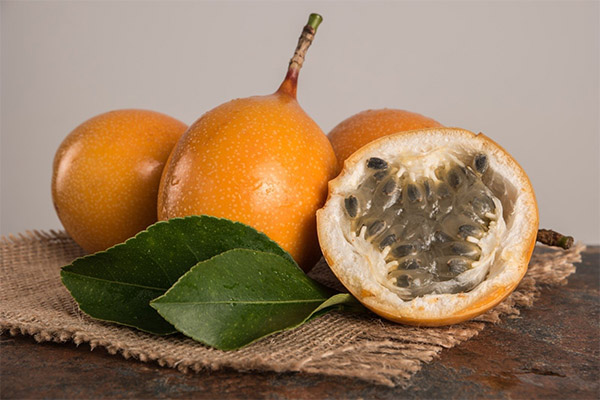
What it looks like
Granadilla is an evergreen plant of the genus Passiflora, belonging to the family of the Passioniflores. It is a tree-like tropical liana that can grow to a height of up to 10 meters. The flowers attract with their exotic appearance: the petals are large and colored in a purple-white shade, inside the buds you can see the light plant tendrils and large green stamen threads with pollen grains. The flower has a very exotic look and unique scent.
There are several species of grenadilla in the world. The most famous species of this tropical plant are yellow and edible. Depending on the species, the fruit may be spherical or oblong in shape, as big as a peach or resemble a small melon. They usually weigh between 150-200 grams. The peel varies in color from pale green, yellow and orange to purple and violet, depending on the variety. Under the skin is a white layer, and inside hides a fragrant flesh with dark seeds in a jelly-like shell.
Types
- Granadilla gigantea has an oval-shaped fruit. It is 10-30 cm long and about 8-12 cm wide. The skin is thin and has a yellowish or greenish surface color. The flesh is white or pink, with large brown and purple seeds inside.
- Granadilla blue is a tropical fruit with a distinctive yellow color, its fruits are oval-shaped. They are 6 cm long and about 4 cm in diameter. If you cut the fruit in half, you can see red kernels inside.
- Granadilla banana has an unusual oval shape. The fruit is 12 cm long and up to 4 cm wide. It is slightly pale yellow or dark green in color, with a sweet orange core and black seeds inside the pulp.
- Granadilla edible is well known to tourists by another name, passion fruit. The tropical fruit has a round, sometimes oval shape. Its size can reach 40-80 mm in diameter. Inside is a juicy flesh with lots of seeds. The color can have a characteristic purple, red or purple color. The passion fruit is often confused with its relative, the yellow grenadilla.
- Granadilla yellow is widely used in cooking. It has a distinctive shape, slightly resembling an egg. The fruit can grow to 6-7 cm in diameter. The skin is slippery to the touch and can have a distinctive yellow, orange or even reddish hue. The ripe fruit has small black spots on its skin. Inside, the fruit has a transparent flesh with small black, flat seeds. These seeds are located throughout the pulp, so it is not easy to get them out. However, they are soft in consistency and are considered edible. You can eat the sweet fruit directly with the seeds, you do not need to remove them. The flesh has a characteristic jelly-like consistency and an intensely sweet taste. The flavor qualities of the exotic fruit are quite diverse. Granadilla combines the sour notes of kiwi, the sweet flavor of strawberry, the aroma of ripe melon and gooseberry.
Where it grows
This tropical plant is native to countries with hot climates. This exotic fruit was first found by Spanish conquistadors who sailed to the Americas in search of new territories. Today, the fruit of the grenadilla can be found in the wilds of Mexico and is successfully cultivated in the hot expanses of Bolivia, Brazil, Argentina, Paraguay and many other countries. Granadilla also grows on vast islands in the Caribbean - Hawaii, Jamaica, Haiti and Guam.
The heat-loving plant has also been tried several times in European countries and even in Krasnodar Krai in Russia. However, it is not possible to obtain the full-bodied flavor of grenadilla in colder climates, and the plant yields only once a year.
Granadilla is different from passion fruit
Pomegranadilla and passion fruit are members of the same family, the Passeriformes. However, passion fruit is considered the more common variety of the plant of this species. Despite the fact that the appearance of these fruits is completely different, many tourists very often can not distinguish these two fruits from each other. In order not to confuse these fruits, it is necessary to highlight their main distinguishing features:
- The passion fruit has a dark purple skin and characteristic "wrinkles", and the pomegranadilla has a rich yellow-orange color.
- Ripe pomegranadilla fruits do not have a tail, while passion fruit often have a stalk that splits off the fruit.
- The passion fruit has a richer color in the flesh.
- Both fruits have a white layer that separates the rind and flesh of the fruit, but passion fruit has a thinner layer.
- The fruits have completely different flavors, with the pomegranadilla fruit being considered much sweeter.
- The passionfruit seeds are much harder, while the pomegranadilla seeds are softer and much easier to chew.
- The passion fruit is much smaller in shape than its yellow relative.
Composition and calories
Granadilla has very high taste qualities. However, this tropical fruit got its popularity not only because of its sweet flesh. The fact is that the fruit has a fairly low nutritional value, while the fruit contains many useful elements. In 100 grams of grenadilla contains about 46 kcal. At the same time, 80.2 g is water, and 10.4 g is dietary fiber. The fruit has only 0.1 g of fat, 8 g of carbohydrates, and 0.5 g of protein.
Granadilla is considered to be a fruit useful for health due to the concentration of many useful elements and vitamins in it. The fruit contains a lot of useful iron. In 100 g there are about 1600 micrograms of iron, thanks to this the fruit of the tropical plant is considered indispensable in the treatment of anemia.
In addition, pomegranadilla contains an abundance of zinc, potassium, copper. These trace elements help patients with high blood pressure, eliminate high edema and contribute to the treatment of other cardiovascular pathologies. Potassium in the composition of grenadilla promotes the positive work of the heart and blood vessels, affects the proper functioning of the urinary system, the functioning of the nervous and muscular tissue in the body. Phosphorus helps to strengthen the human bone tissue, to produce ATP acid, which is the main energy carrier.
Granadilla fruits also contain elements necessary for the body, such as sodium, selenium, magnesium, and B vitamins. They play an important role in the proper functioning of the body's metabolic processes, contribute to the creation of blood cells, help produce antibodies and influence the development of the reproductive and endocrine system.
Thanks to the vitamin C contained in these tropical fruits, the human body produces essential collagen, stimulates the production of hormones, neutralizes histamine, and produces red blood cells. This vitamin has a positive effect on the human immune system and helps to fight colds.
Useful properties of the pomegranadilla fruit
This tropical fruit has a full composition of all the necessary vitamins and trace elements that strengthen the human body, promote bone growth, relieve insomnia and eliminate headaches.
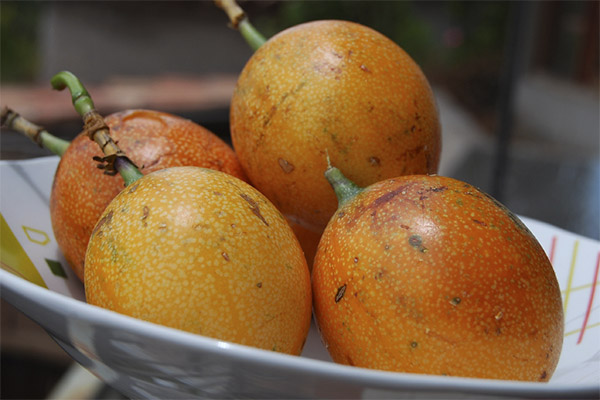
For women
The substances contained in the tropical fruit - vitamins, hydroxy acids and antioxidants - promote better hair and nail growth in women. That's why the tropical fruit is often used in the cosmetic industry: added to shower gels, hair shampoos, lotions and creams for the body and face.
Creams and lotions based on pomegranadilla help to combat skin problems, giving it a firm and fresh appearance, creating a lifting effect. Useful vitamins and trace elements in the fruit combat skin irritation, cleanse, soothe and heal problem areas of the body. They help fight the manifestation of dermatitis, psoriasis, relieve the skin from dryness and rashes.
Pomegranadilla fruits are especially beneficial for the female body in case of problems with insomnia and frequent depressions. The exotic fruit can help get rid of frequent migraines and restore a healthy sleep. After all, the composition contains essential oils that have a sedative effect, getting rid of neuroses and restless state.
For men
Thanks to a wide vitamin and mineral complex, grenadilla supports the overall tone of the entire body in men. The beneficial substances in the fruit help you recover quickly, for example, after physical exertion or training at the gym.
Pomegranadilla fruit also contains vitamin B9, which is so necessary for men for the proper functioning of the genitourinary system. It helps maintain sperm viability. In addition, the vitamin normalizes all processes in the body, including the proper functioning of the bone marrow, protects against the appearance of tumors.
In pregnancy
Pomegranadilla fruits during pregnancy saturate a woman's body with all the useful vitamins and trace elements. The fruit can be added to yogurt, cottage cheese, make fruit salads or smoothies from them. In addition, the tropical fruit contains folic acid, necessary for future mothers, which contributes to the proper development of the fetus.
However, it is best to consult your personal gynecologist on this matter. Women should eat the fruit only after approval of a specialist because of the drowsy effect of granadilla seeds. If the fruit is eaten frequently, the expectant mother may feel very tired and drowsy. Despite all its useful properties and vitamins, in some cases, the use of pomegranadilla may also cause allergic reactions in the body and adversely affect the development of the fetus.
When breastfeeding
During the period of breastfeeding, new mothers are better to refuse to eat the exotic fruit for a while. At least in the first three months should not consume pomegranadilla, as there is a possible risk of severe gas formation in the baby or the development of allergies.
For babies
Because of the risk of allergic reactions, the exotic fruit should not be offered to children under three years of age. Pomegranadilla fruits can provoke allergies in the immature child's body and cause side effects in the digestive tract. However, vitamin B (riboflavin) contained in the fruit of the plant is considered the main building block of the body and is necessary for proper growth and development of the child. And vitamin B6 contributes to the formation of proteins and the proper operation of the metabolic processes of the whole child's body.
For losing weight
Due to the fact that the pomegranadilla fruits belong to the low-calorie type of products, they can be eaten in problems with obesity. The high content in the exotic fruit helps to eliminate toxins and cleanse the body. Due to the large vitamin complex, grenadilla is useful for people who are actively engaged in sports and want to maintain their body in excellent physical shape.
Pomegranadilla is considered to be a low-calorie product containing a lot of useful substances. Therefore, dishes and drinks with its addition are great for people who want to lose excess weight and take care of their health.
Hazards and contraindications
With caution, the tropical fruit should be used by people who have an individual intolerance to the product or tendency to allergies. However, there are practically no particular restrictions on the use of pomegranadilla fruits.
However, this fruit should be used with caution in patients who suffer from diabetes. It is also important not to overconsume the fruit for people who have a tendency to gain excessive weight. Although pomegranadilla is considered to be a low-calorie product, still the fruit contains a high concentration of fructose. And this can lead to a spike in blood sugar, resulting in an increased feeling of hunger.
In addition, the exotic fruit has diuretic and laxative effects. This is why you should not abuse the fruit too much, especially for those patients who are prone to the manifestation of diarrhea.
How to pick and store
In tropical climates, grenadilla usually bears fruit twice a year. Therefore, in warm countries, the crop can be harvested several times. The abundant fruit is harvested after the rainy season is over. This is worth considering for tourists who buy exotic fruits during their trip abroad.
Today you can find grenadilla on the shelves of almost all major supermarkets in the world. This exotic fruit is exported to other countries almost year-round. However, the fruit brought from afar may not possess all its taste and useful properties. The fact is that it is impossible to bring ripe pomegranadilla fruits without damaging and spoiling them. In order for the exotic fruit to retain its freshness and beautiful appearance as long as possible, the rind is chemically treated. Therefore, it is not recommended to use the skin of exotic fruits brought from afar in supermarkets for food.
When choosing pomegranadilla, it is important to remember that its fruits are perishable. And the approximate shelf life of the fruit is only a week at room temperature. At the time of purchase, you should pay special attention to the condition of the rind. The skin of the fruit should be smooth and dense to the touch. The ripe fruit is usually covered with small black spots on the skin surface. Its weight is about 200 grams. If you accidentally come across pomegranadilla without the characteristic dark spots or strongly soft, such a fruit should not be bought.
How to eat grenadilla
This exotic fruit is best eaten fresh. In terms of taste, pomegranadilla has a sweet, slightly watery flavor. The jelly-like flesh with seeds inside resembles very much the taste of gooseberries or melons. The most sour varieties of pomegranadilla can be combined with sugar or honey, while the sweet ones are cooked with salt and pepper as an appetizer.
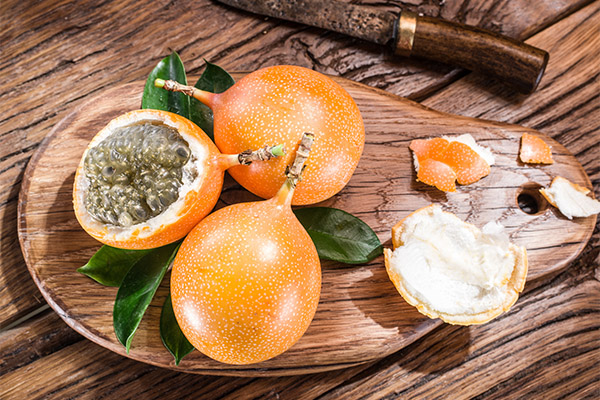
Pomegranadilla fruits are great with fresh salads and as appetizers, the fruit is added to desserts, made into casseroles, puddings and freshly squeezed juices.
How to peel a pomegranadilla
Peeling the fruit is simple enough. To do this, take a sharp knife, carefully divide the fruit into two halves, making an oblong incision 5 mm deep. The flesh and seeds are edible, and you can easily get them out with a teaspoon. There is no need to separate the core of the fruit from the seeds. Pomegranadilla seeds are soft enough, easy to chew, and do not cause discomfort to digestion.
Can I Eat the Seed
There are a lot of seeds in the grenadilla fruit; they are almost never separated from the flesh. Despite their large number, they are hardly noticeable while eating the fruit. The pomegranadilla seeds are very tender, soft and fragrant. They are considered edible, so the seeds are not taken out of the fruit before cooking or eating them raw.
Cooking Uses
The pomegranadilla is usually used fresh in cooking. The local natives eat the fruit without treating it with heat, just eating the flesh with a spoon.
The pomegranadilla fruit is used more extensively around the world. Because of its exotic sweet and sour taste, it is used as an additive to meat and fish dishes. The pulp of the unripe fruit is stewed alone and also combined with other vegetables.
Fresh juices, syrups, tinctures and liqueurs are made from the fruit pulp, and added as the basis for alcoholic and non-alcoholic cocktails. Granadilla is great with other fresh juices, such as orange, kiwi or mango.
Because of its natural jelly-like consistency, the fruit is great for making jellies, jams, dessert dishes, sweet salads, and as a filling for puddings and baked goods. Because of its high sugar content the fruit is added to baked goods and confectionery. And because of its amazing aroma and flavor, pomegranadilla is also used as a natural flavoring in the basis of yogurts and sweet sauces.
Spring Exotic Salad
Dish ingredients:
- 1 ripe pomegranadilla fruit;
- 10 strawberry fruits;
- salad mix;
- 1 white turnip;
- 1 bunch of green onions;
- pumpkin seeds for decoration;
- parmesan for decoration;
- sugar, balsamic vinegar and sesame oil for dressing to taste.
Place lettuce leaf mixture on plate, chop turnips, dice strawberries, chop green onions and place on plate. Cut the pomegranadilla fruit in half and take out the sweet pulp for the salad. Mix the dressing in a separate bowl. Add balsamic bite, sesame oil, sugar and mix everything well. Dress the salad with the dressing. Before serving, garnish the salad with pumpkin seeds and grated Parmesan.
Sweet pomegranadilla sauce for meat
Dish ingredients:
- 80 ml of tropical juice (pineapple, multivitamin or mango);
- 1 chili pepper;
- 1 ripe pomegranadilla;
- 2 tsp. sugar;
- 1 tsp. starch;
- 1 tsp. cold water.
Pour the tropical juice from the tetrapak into a saucepan. Finely chop the chili peppers and add to the juice. To make the peppers less spicy, remove the seeds or put them in the sauce. Slice the fruit of one ripe grenadilla and take out the sweet pulp. We put the pan with the juice on a small fire, pour the sugar and stir. Dilute the starch in 1 tsp of cold water. After the liquid in the pot boils, turn down the heat on the stove, add the pomegranadilla pulp and stir. A thin trickle pour into the pot diluted in water starch. Stir constantly. The sauce should become thick, then remove the pan from the heat. Such a spicy spicy sauce with a sweet taste will be a great addition to pork meat dishes.
Granadilla fruit mousse
Ingredients of the dish:
- 2 ripe pomegranadilla fruits;
- 3 ripe bananas;
- 25g of butter;
- 1 large kiwi;
- 0.5 cup of cream with 22-33% fat content;
- 35 g granulated sugar;
- 1/3 of the juice of a small lemon.
Peel and mash bananas with a fork. In a water bath melt a piece of butter and pour into the crushed banana puree. Peel the pomegranadilla fruit and remove the soft core. Thoroughly mix the pomegranadilla and mashed banana until smooth. Put the puree in the fridge to thicken. Peel the kiwi, chop it and add the juice of the lemon. Next, whip the cream and sugar until a thick homogeneous mass. Add the whipped cream to the mashed bananas and pomegranadilla fruit. Take a nice container to serve. Put the chopped kiwi, then the puréed mass of bananas and pomegranadilla in it. Do not mix the fruit. Chill in the fridge for a couple of hours to thicken before serving.
Exotic cottage cheese casserole
Ingredients of the dish:
- 2 ripe pomegranadilla fruits;
- 2 tbsp. butter;
- 450-500g of cottage cheese (9% fat);
- 80g granulated sugar;
- 1 chicken egg;
- 1.5 tbsp. starch.
Peel the pomegranadilla fruit, remove the soft core, squeeze the juice from the fruit and add the starch. In the cottage cheese beat the egg, pour the sugar and mix everything thoroughly. Stir the cottage cheese with the squeezed juice and starch. The resulting curd mass is poured into a baking dish. Grease the form beforehand with butter. Bake the casserole in the oven for about half an hour at 180-190 degrees. After cooking, cool the casserole and put it in the refrigerator for a few hours before serving. The cottage cheese can be garnished with whipped cream and fruit pulp.
Tropical Afternoon Pudding
Dish ingredients:
- 3 ripe grenadilla fruits;
- 2 ripe limes;
- 120g brown sugar;
- 60 g flour;
- 60 g butter;
- 2 chicken eggs;
- 0.5 cup milk;
- 1 tsp. baking powder.
Separate the yolks from the whites in the chicken eggs. Beat the yolks with 60 g of brown sugar. Then add soft butter to the yolks and knead until homogeneous. Add flour and mix everything well. Wash the fruit under water. Grate the lime zest and squeeze the juice out of the remaining fruit. Then we take out the pomegranadilla flesh. Whisk the egg whites with the remaining brown sugar. Gradually add the lime juice and all the remaining ingredients. Preheat the oven to 180-190 degrees and bake the pudding until golden. When serving, garnish each piece of pudding with a spoonful of sweet pomegranadilla pulp.
Interesting facts
There are more than 500 species of grenadilla. This is the reason why there are so many different names for the plant. Tourists often call this fruit passionfruit, passiflora and even passion fruit. However, the name grenadilla has the most authentic roots, as it comes from the Spanish dialect. As we know, it was the Spanish conquistadors who first introduced this tropical fruit to the Old World.
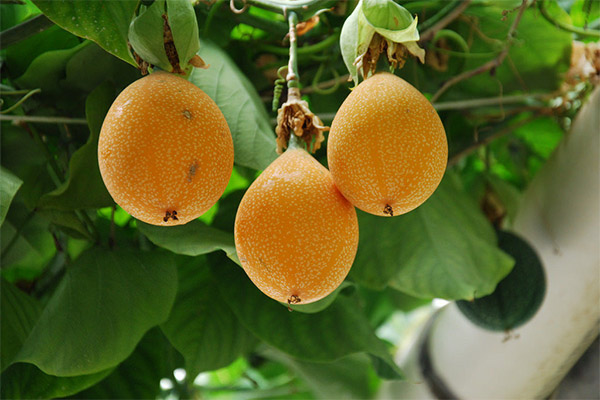
Some also believe that the name grenadilla has French roots and translates as "pomegranate" or grenadille. This fruit may have earned its name because of the large abundance of seeds inside the pulp, which makes it associatively similar to a pomegranate.
However, the most interesting name for this fruit can be considered the name "passiflora". This name is closely related to the English phrase passionfruit, which means "fruit of passion". This name is firmly attached to the tropical fruit for one simple reason: many tourists believe the grenadilla to be an aphrodisiac. However, this opinion is mistaken. In reality, the plant has no such medical properties at all. And such an unusual name is more associated with the religious interpretation - the crucifixion of Christ and his suffering. Therefore, the word "passion" in the name has nothing to do with the word "attraction". On the contrary, it must be interpreted as the "suffering" of Christ.
This theory was advanced in 1610 by the Italian and historical figure Giacomo Bosio. The historian and faithful spokesman for the church was convinced that the tropical plant embodied the sufferings of Christ. The outside and inside of the flower's crown represented Jesus' crown of thorns, the pistils symbolized the nails with which the Savior arrived at the cross. The plant's pointed leaves resembled a spear penetrating the body, and the glands placed inside the petiole represented the silversmiths Judas received.
«Important: All information on this site is provided for informational purposes only purposes only. Please consult with a health care professional before using any of our recommendations. professional before applying any recommendations. Neither the editors nor the authors shall be liable for any possible harm caused by materials."

